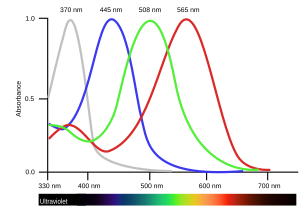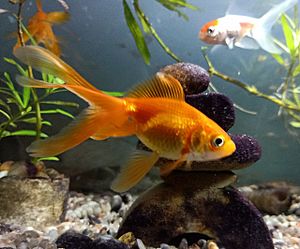Tetrachromacy facts for kids
Tetrachromacy is when an animal has four different types of special cells in its eyes that help it see color. These cells are called cone cells. Animals with tetrachromacy are called tetrachromats.
Imagine a world where you could see even more colors than you do now! For tetrachromats, their world is full of extra colors. They can mix at least four primary colors to create all the colors they see.
Many animals are tetrachromats, including some birds, fish, amphibians, reptiles, insects, and even some mammals. Long ago, most mammals could see four colors, but over time, many lost two of their color-sensing cells.
Contents
How Animals See More Colors
Animals with tetrachromacy have four kinds of special cells in their retinas. These cells, called cone cells, are like tiny sensors that pick up different light waves. Each type of cone cell is sensitive to a different range of colors. This means these animals can see colors that humans cannot, like ultraviolet light. They can also tell the difference between colors that look the same to us. Having this super color vision can give these animals an advantage in finding food or avoiding danger.
Animals with Tetrachromacy
Fish with Super Sight
Some fish, like the goldfish (Carassius auratus auratus) and zebrafish (Danio rerio), are tetrachromats. Their cone cells can see red, green, blue, and ultraviolet light.
Birds' Amazing Color Vision
Birds like the zebra finch and doves use their tetrachromatic vision to see ultraviolet light. This helps them find mates and food. For example, the bright ultraviolet colors on a bird's feathers can show how healthy and strong it is, helping it attract a partner.
A typical bird's eye can see light from about 300 to 700 nanometers. Most birds have four types of cone cells. Their vision is even better because they have tiny, colored oil droplets in their eyes. These droplets filter the light before it reaches the color sensors, making their color vision even sharper than ours.
While birds see a wider range of colors than humans (because they see ultraviolet light), their ability to tell apart very similar shades might be about the same as ours.
Insects and Colorful Flowers
Insects that collect nectar, like bees, can see the colors that flowers reflect. This range goes from 300 nanometers (ultraviolet) to 700 nanometers. Flowers and insects have grown together over time. Flowers have developed many different colors, including ultraviolet patterns, to attract more insects for pollination. This helps both the plants and the insects!
Mammals and Their Vision
Most mammals today only have two or three types of cone cells.
Reindeer's Special Vision
In places where reindeer live, the sun stays low in the sky for a long time. This means there's a lot of ultraviolet light. Reindeer can see ultraviolet light, which helps them spot things that stand out against the snow. For example, they can see urine (which might mean predators are nearby), lichens (a food source), and even the fur of wolves (their predators). Reindeer don't have a specific ultraviolet sensor, but their other sensors can pick up ultraviolet light. Some scientists think this is why reindeer avoid power lines, as the lines might appear to flicker with ultraviolet light in the dark.
Can Humans Be Tetrachromats?
Apes (including humans) and Old World monkeys usually have three types of cone cells, making them trichromats. This means they see three primary colors: red, green, and blue.
However, some people, especially women, might have a fourth type of cone cell. This is because the genes for two of our cone cells are on the X chromosome. Since women have two X chromosomes, they could have more types of cone cells.
Scientists have studied women who might have four types of cone cells. One study suggested that about 15% of women might have a fourth cone cell that helps them see more colors. Another study thought it could be as many as 50% of women and 8% of men! In 2010, after 20 years of research, a scientist named Gabriele Jordan found a woman who could truly see more colors than people with three cone types.
Even if someone has four types of cone cells, it's not fully known how their brain would use this extra color information. Our eyes send color signals to the brain, but we don't know if the brain is set up to process a fourth color channel separately.
Humans can't usually see ultraviolet light directly. This is because the lens of our eye blocks most of the ultraviolet light. Even if our color-sensing cells can detect some ultraviolet light, it doesn't reach them. If someone has had their lens removed (a condition called aphakia), they might see ultraviolet light as a bluish-white color.
Having tetrachromacy might also help animals see better in dim light or when looking at screens.
See also
 In Spanish: Tetracromatismo para niños
In Spanish: Tetracromatismo para niños
- Trichromacy
- Mantis shrimp (these amazing creatures can see up to 12 colors!)
- How color vision has changed over time



